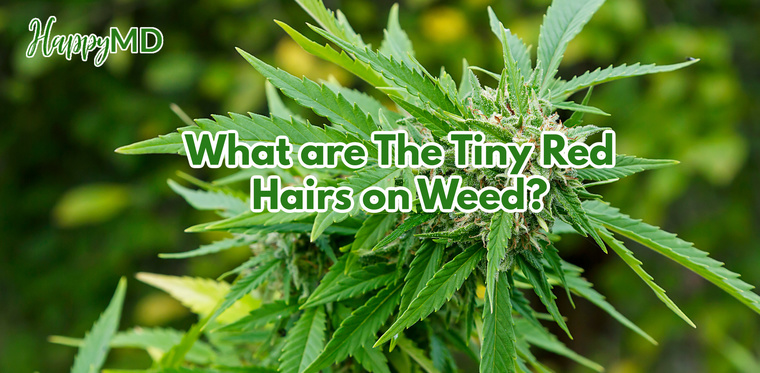
Tiny Red Hairs on Weed: What are They?
When you take the time to study the marijuana part, you will get a deeper insight into the plant's anatomy. Many people always recognize when they have grown a good batch.
Telling the difference between an indica- and a Sativa-dominant breed is significant, and knowing the individual features is helpful. However, it is usually hard to understand all the parts of the plant’s anatomy. You might have the:-
Cola: This is the flower growing at the very end of a branch. A farmer can also refer to the giant bud growing at the end of the main stem.
Bract: These green leaves usually have a teardrop shape and resin glands covering them.
Calyx: This is the actual bud. It is usually composed of a clump of sugar leaves resulting from trichomes covering the leaves.
Fan Leaves: These are the giant leaves that are usually considered the most critical part of the harvest. Their main use is in the creation of edibles.
Nodes: This is where the leaves on the cannabis plant grow out from. They form the central part of the leaves and give the weed leaves their unique appearance.
You are probably wondering why the pistil has been left out in our description of the anatomy of a marijuana plant. The pistil is the female sex organ on the cannabis plant and has tiny hair-like strands which collect pollen from the male plants.
These hairs immediately get pollinated when they are touched by the pollen from the male marijuana plant. The stigmas are usually white but gradually get darker and change from yellow to orange.
With time, they become red, and eventually, they turn into a brown color which usually depends on what strain of marijuana it is. It is not good to let the pistil develop a seed as a grower since this marks the end of the growth cycle. This is because the plant will be less potent when mature seeds.
Young Cannabis Plants and Pistils
The young make cannabis plants are known to grow preflowers before the females. You can distinguish between male and female plants within the first 3 to 6 weeks after germination.
These are known to increase randomly, so it becomes easier to spot them. The flowers are usually on the stipule, a green hair-like growth where the preflower develops. White hair signifies a female plant.
Mature Cannabis Plants and Pistils
Any time you notice a male cannabis plant growing in your garden, get rid of it as soon as possible. You do not want the making plant fertilizing the rest of your crop.
For mature plants, the stigmas are long hairs and usually indicate when your plant is ready to be harvested. Once a bud has been formed, you will notice plenty of white hairs coming out of the plant. These will remain white for 4-5 weeks but eventually create a yellow color.
The color usually depends on the strain you are growing, and knowing the color will indicate when it is ideal for harvesting your crop. As a general rule, you should let at least 50% of your stigmas change color before starting the harvest process.
Growers with more years of experience usually wait until 70-80% of their stigmas have changed color, which is when the buds are most potent. You can also get a magnifying glass to check the trichomes in the crop.
Do Not Wait Too Long
If you wait for longer than is required, the stigmas are usually known to start turning dark brown and drying out.
The weed is still potent enough to get you high, but the only difference is that some of the THC will have started to degrade into CBN, which means that the taste and potency of the weed will be massively affected. Most cannabinoids in cannabis plants are usually in the pistils and calyxes. This is in the flower part, which is the plant's main product.
The seeds are generally the main challenge and will be difficult to remove when you let your female plants keep on growing after pollination. You should expect an unpleasant smoking sensation and bouts of coughing whenever you have seeds in your weed.
My Buds Keep Growing New Pistils. What To Do
As a beginner, you should ideally stick with a single strain of marijuana. This will ensure that your plants are all ready for harvesting at around the same time.
Some strains are known to mature at the buds at the top of the plant, while others will start to mature the buds at the bottom sections of the plants. This might confuse and is always a challenge when it is time to harvest.
However, it is always right when you decide to harvest in stages, starting with the most mature weed. Stress caused by heat could cause the pistils to begin growing to the parts that are exposed to the light. The light might also cause the buds to start developing in strange shapes.
When this happens, be sure to look at the older parts of the plants to determine whether they are ready for harvesting. Plants are also known to grow new pistils when they are in the flowering stage, a case that is common in the Sativa and Haze varieties.
The moment your plant starts developing pistils that are extra healthy, be sure to reduce the number of hours exposed to the light. With longer nights, your plant will be able to mature faster, and it will stop growing new pistils or pistils that have strange shapes.
Final Thoughts
The red hairs that are usually found on cannabis are also known as Stigmas and are a part of the pistil. The bids are of high quality usually have pistil that has plenty of hairs. The hair color is known to change with time as the cannabis plant matures. They typically change from a white color to red, yellow, and brown colors, indicating that it is the right time to harvest your crop.
References
1. https://www.wikileaf.com/thestash/red-hairs-weed/
2. https://cannabis.net/blog/strains/what-are-those-tiny-red-hairs-on-cannabis-buds
3. https://kushfly.com/blog/what-are-those-little-red-hairs-on-weed/
4. https://www.rollitup.org/t/are-too-many-red-hairs-a-bad-thing.447405/
5. https://weedhub.ca/faq/what-are-the-orange-hairs-on-weed/


.png)